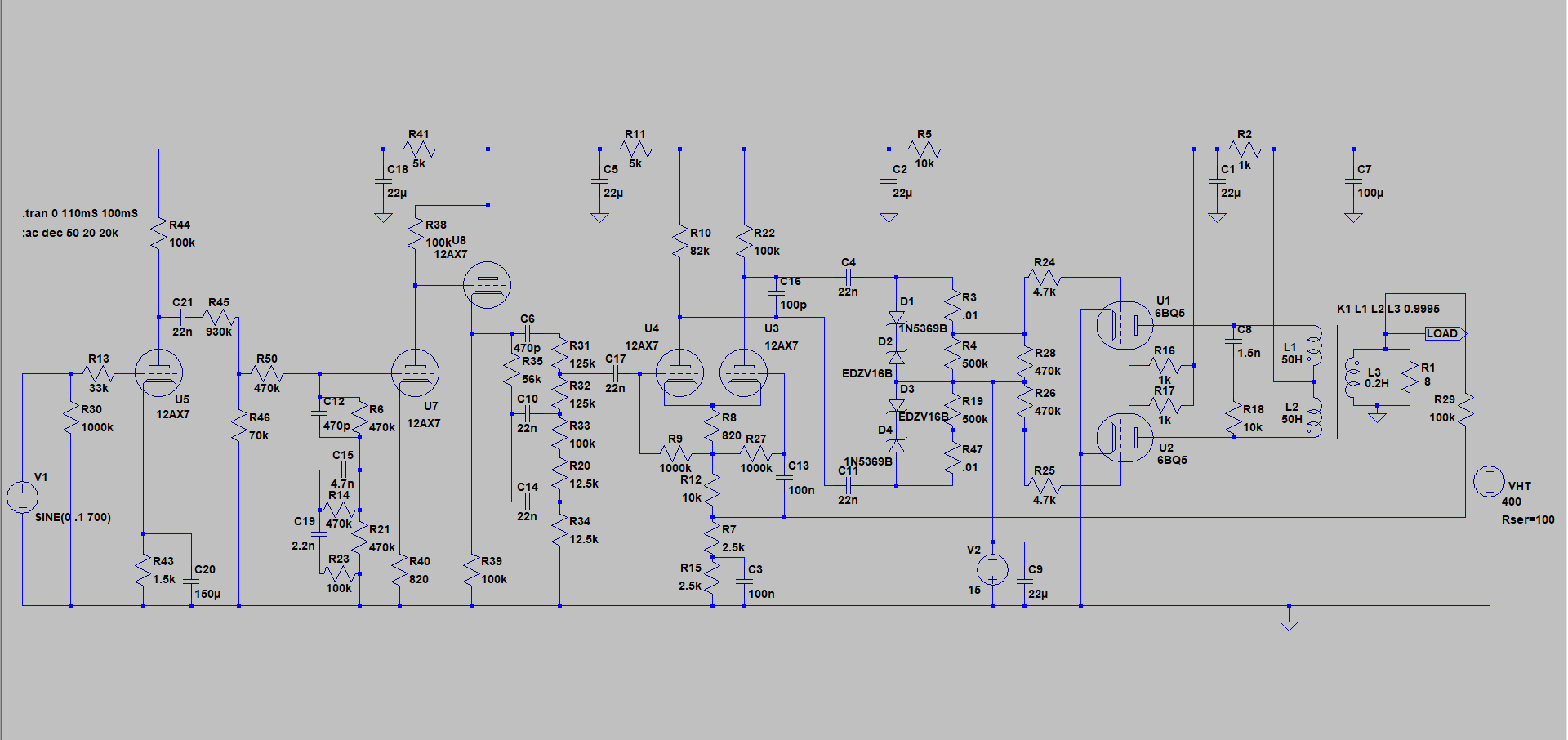I never liked the PPIMV circuits for the obvious reasons. With the amps they're intended for you basically just get PI clipping instead of power tube clipping. And no PI circuit I'm aware of is known for it's good clipping. Sooo...
Sort of like the the Paul Ruby mod, but inverse. Use a zener to clip the positive swing a volt above the bias voltage. That way when you turn down the master the diode takes over the signal clamping duties.
The circuit shown below is just a plexi Marshall type preamp into an el84 power amp (the weird circuit behind the second triode is a simulation of the parallel channels load affect). But of course you could do this with any power tubes by valuing the zeners according to measurements taken with your meter.
One hitch I came across was that the clamping alone wasn't sufficient once the master was down and the peak to peak drive signal to the power tube grids started to approach the bias voltage. At that point the amp starts operating nearer class A and the negative swing on the PI signal begins to show up. So I used another zener to clip the negative swing at that threshold. This does implement a little of the "Paul Ruby" affect and mitigate some crossover distortion. So the absolute master full up, stock amp tone is affected a little by a reduction in crossover distortion. In the circuit below the value for the zener on the negative swing is 51V. If you really only want to use the master for heavily clipped tones it can be valued larger for less of an affect on the stock tone. Though I don't think the loss of a little crossover distortion should be objectionable for most players.
Another benefit to the zeners and the preserved signal clamping is that it greatly improves the taper of the master volume function. The range of volume across adjustment is much more even whereas without the diodes most of the useful adjustment is below about three on the knob.
Sorry that the picture is a little low res. It's a cut and paste of LTSpice images. Hopefully you can zoom it if necessary to see the images.


Sort of like the the Paul Ruby mod, but inverse. Use a zener to clip the positive swing a volt above the bias voltage. That way when you turn down the master the diode takes over the signal clamping duties.
The circuit shown below is just a plexi Marshall type preamp into an el84 power amp (the weird circuit behind the second triode is a simulation of the parallel channels load affect). But of course you could do this with any power tubes by valuing the zeners according to measurements taken with your meter.
One hitch I came across was that the clamping alone wasn't sufficient once the master was down and the peak to peak drive signal to the power tube grids started to approach the bias voltage. At that point the amp starts operating nearer class A and the negative swing on the PI signal begins to show up. So I used another zener to clip the negative swing at that threshold. This does implement a little of the "Paul Ruby" affect and mitigate some crossover distortion. So the absolute master full up, stock amp tone is affected a little by a reduction in crossover distortion. In the circuit below the value for the zener on the negative swing is 51V. If you really only want to use the master for heavily clipped tones it can be valued larger for less of an affect on the stock tone. Though I don't think the loss of a little crossover distortion should be objectionable for most players.
Another benefit to the zeners and the preserved signal clamping is that it greatly improves the taper of the master volume function. The range of volume across adjustment is much more even whereas without the diodes most of the useful adjustment is below about three on the knob.
Sorry that the picture is a little low res. It's a cut and paste of LTSpice images. Hopefully you can zoom it if necessary to see the images.

Comment